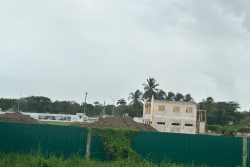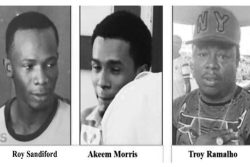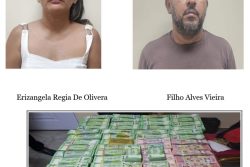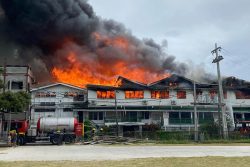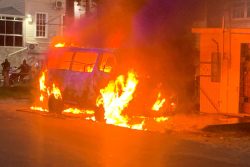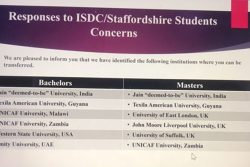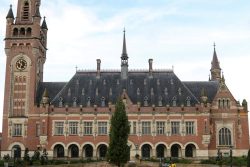Most of the cocaine being exported from Guyana is likely coming from Venezuela via the Pomeroon, the Customs Anti-Narcotics Unit (CANU) says and the nexus between that trade and gun-running is increasingly clear, sources say.

In the wake of three large busts in Canada, the US and the US Virgin Islands of cocaine-filled shipments which originated from Guyana, questions have been raised about where the drugs are coming from and about the repackaging operations here.
CANU sources tell Stabroek News that around 60% of the cocaine that enters Guyana comes from Vene-zuela and transits through the Pomeroon. There is a lot of unmonitored boat traffic between Guyana and Venezuela which also accommodates gun-running. Drug trafficking, transport of guns and smuggling of fuel are intertwined in these areas and complement each other.

A portion of the drugs that enters the country from Venezuela goes farther east to Suriname by go-fast boats and there is an easy convertibility between the drug and gun-smuggling trades. For instance, in Suriname the going rate today for two Chinese-made AK-47s is a kilo of cocaine.
Questions linger over how and where the exporters in Guyana are packaging their drugs in these big shipments.
On December 8, officers found 276 kilos of high-quality cocaine at the Port of Saint John, New Brunswick, aboard a ship, Tropic Canada.
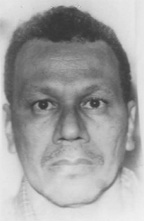
The Toronto Star reported investigators as saying that the vessel in New Brunswick was confirmed to have been carrying 77-79 per cent pure cocaine, which was found inside the cardboard dividers of boxes of hot sauce. They removed all but two kilos of the cocaine and performed a controlled delivery of the container to its original destination in Etobicoke, Ontario. It was received by the owner of the company, Mahendrapaul Doodnauth, who unloaded the boxes at a rented storage facility on Rexdale Boulevard in Toronto. As a result, Doodnauth, of Toronto, was charged with importing cocaine, conspiracy to import cocaine and possession of cocaine for the purpose of trafficking.
A second major drug shipment was traced back to Guyana after US federal agents on December 24 seized 100 kilos of cocaine found inside pepper sauce cartons aboard a ship in St. Croix, U.S. Virgin Islands. The US agents had been tipped off by Canada.

Then on the heels of two major pepper sauce busts, customs authorities at the Port of Miami, on December 29 acting on a tip off unearthed 373 pounds of cocaine hidden in furniture aboard a vessel, whose last stop was in Georgetown.
CANU sources yesterday said that both investigations are making headway. In relation to the pepper sauce shipments, a significant amount of information has been exchanged with Canada’s Royal Canadian Mounted Police and CANU is preparing to reel in more suspects. One of the suspects that CANU issued a bulletin for, Indarpaul Doodnauth, made himself available to the agency for questioning. Doodnauth, an East Coast-based businessman is the brother of Mahendrapaul Doodnauth, the man held by Canadian authorities in connection with both shipments of the pepper sauce cocaine. Canada is proceeding with its investigation and staying in touch with local law enforcement agencies.
Another man sought by CANU, Reginald Rodrigues, who was thought to be the shipper of the pepper consignment seized in Canada went underground after the bust became public and was able to evade an attempt to arrest him here. It is believed he has since fled to Suriname via the backtrack.
Another man wanted for questioning in relation to the pepper sauce, Orlando Watson has been in touch with the authorities here but is yet to turn himself in. He is thought to be connected to the second shipment. CANU sources say they are actively seeking two other businessmen who participated in the pepper sauce cocaine shipment and based on information from their lawyer they may turn themselves in for questioning. The two are associated with a business in Georgetown.
CANU sources say that the pepper sauce shipments were financed by a coterie of shady characters and persons with criminal antecedents who were looking to make a whopping profit from their Christmas operation. With the crushing of the operation some of the suspects are not only being sought by CANU but also by their financiers.
A suspect in the shipment of the cocaine furniture to Miami, Nymrod Singh, was nabbed in Bartica on Saturday after his photograph appeared in the newspapers. He spent his second day in custody yesterday and sources say he is saying that an acquaintance asked him to ship the furniture to Miami.
The furniture was allegedly picked up by Singh on November 1 and next appeared containerized on November 25 at a city wharf for loading onto the MV Rio Para.
This bust involved 194 packages valued at US$5.5M which was concealed in 72 pieces of furniture packed into the container.
According to NBC6.NET, the Customs and Border Protection (CBP) Officers inspecting the containers at the Miami seaport were alerted by a CBP K-9 to a specific container loaded with furniture.
The officers, attached to the Anti-Terrorism Contra-band Enforcement Team, proceeded to examine the furniture and discovered three packages concealed within one of the pieces of furniture. One of the packages was tested by the officers and the substance was positive for cocaine.
More packages of the drugs were discovered in 71 other pieces of furniture.
According to the Canadian press, the pepper sauce busts are part of a major anti-narcotics initiative dubbed “Project Falcon,” which sought to identify the sources of the criminal network that transported cocaine to street gang members and drug abusers in the Durham region.
The local investigations have also unearthed weaknesses in customs operations which enable the illicit shipments.
In one of the pepper shipments a fake Taxpayer Identification Number was used and the name of a non-existent company provided. Documents for the second pepper shipment appeared to be a copy of that provided for the first.
In relation to the furniture shipment, it was discovered that containers are being packed and sealed at locations where there isn’t adequate inspection. These containers are then taken to the wharves and shipped without any further checks of their cargo.
